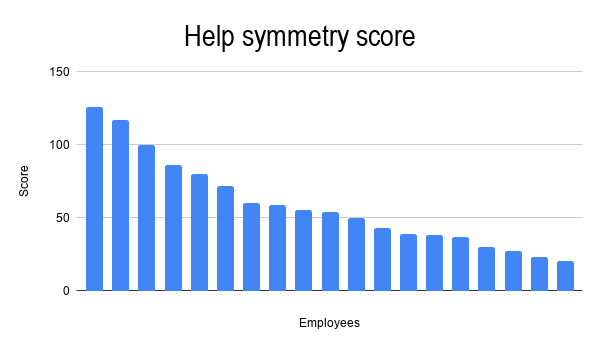This post is to help folks measure if they have a helpful culture in their teams. We are sharing something we do to try and keep Qxf2 a fair place. In this post, we outline a metric called ‘help symmetry score’ that Qxf2 (a fully remote company) uses to figure out if we are nurturing a supportive environment. You might want to try something like this at your company too.
Method
We send out a survey to our employees every week. It has only two questions:
a) who helped you?
b) whom did you help?
Help is anything that an individual deems as help. So, for some that includes concrete tech help. While for others, it might be something someone said that got them thinking in a new direction. We do not measure how many times one person helped the other during the week. We also do not measure the size of help provided.
Why we ask these two questions
By chance, we read two studies back to back that both claimed to identify the number one trait for producing great teams:
a) Google’s People Analytics team identifies psychological safety as a key factor in great teams
b) A Stanford professor’s research found that small wins or the feeling of making meaningful progress every day is the key to sustaining great teams
What struck us at that time was that there are two highly interdependent behaviors that map very well with the above research:
1. How often do people ask for help publicly?
2. How often are our colleagues able to swoop in and unblock us?
In environments that are high on psychological safety, people feel comfortable asking for help when they are blocked. They know the response is going to be non-judgmental and that their ignorance is not going to be punished. How often your colleagues swoop in to help you depends on a number of factors like how busy they are, how skilled they are, how well rewarded they are for helping others, etc.
The two feed behaviors feed off each other. So we decided to measure the two behaviors at Qxf2 using a weekly survey.
Help symmetry score
Since both helping others and asking for help are important, we came up with one metric that we call the ‘help symmetry score’.
help symmetry score = (your 'helping' score*100)/(your 'helped' score)
where, for a given time period,
– your 'helping' score = number of times you helped/number of times the most helpful person helped others
– your 'helped' score = number of times you asked for help/number of times the most helped person asked for help
Intuition behind the score values
A score above 100 will mean you are provide more help than you ask for help. A score below 100 will mean you ask for more help than you provide. We think anywhere from 75 to 125 is good. It means you roughly take help and give help at around the same rate.
Use cases
We find this metric helps us keep Qxf2 a fair place. As we grow larger, we will be out of touch with the efforts and work of our colleagues. We cannot be sure if things are chugging along fine because of the collective effort or because of a few, quiet stars. So we find this metric very useful in gauging the group behavior of the company.
At an individual level, these metrics are less useful unless the individual score is drastically low or drastically high. The one place where we find individual metrics useful is when we have a new hire. If a new hire’s symmetry score pretty low, it means that several people are helping them out and that is a good sign!
Our results
Based on the data from the last ~80 weeks, this is how we do. The graph below shows only the current employees. The employee names have also been scrubbed since we do not want to share that here. We also have about five new employees (< 24-weeks) shown in the graph.

Analysis
These are our takeaways:
a) Only 5 employees out of 19 are in the Goldilocks zone of 75-125
b) The 5 new employees have the lowest score and that is a good sign. It means several people in the team are helping them out.
c) The remaining (about half the company) seem to be clustered around a score of 50 – they take help roughly about twice as often as they give help.
d) There is no rock-star/ninja/know-it-all in the team who helps others but does not learn from others. If there were, their help symmetry score would be much higher than 100.
Overall, based on this data, Qxf2 is still not a very fair place. A quarter of the people seem to shoulder a majority of the burden of helping others while also responsibly asking for help from others. We have work to do!
How do I plan to act on this information? I honestly do not know. I am glad the on-boarding of new hires is going well. However, I am not sure how to make folks volunteer help more often. For now, I am sharing this on the blog and hoping someone will give me ideas. Thoughts, questions and comments are welcome!
I want to find out what conditions produce remarkable software. A few years ago, I chose to work as the first professional tester at a startup. I successfully won credibility for testers and established a world-class team. I have lead the testing for early versions of multiple products. Today, I run Qxf2 Services. Qxf2 provides software testing services for startups. If you are interested in what Qxf2 offers or simply want to talk about testing, you can contact me at: [email protected]. I like testing, math, chess and dogs.
